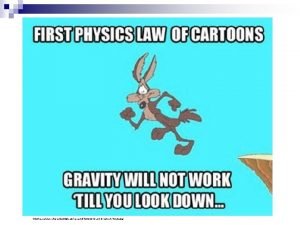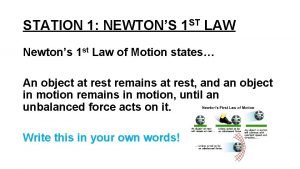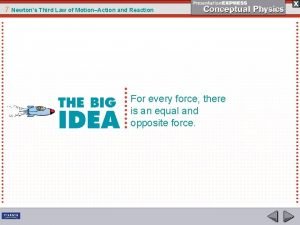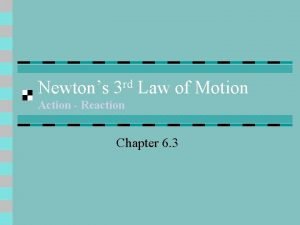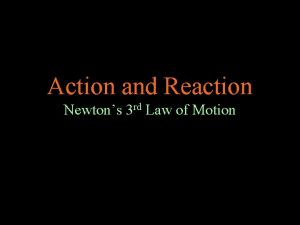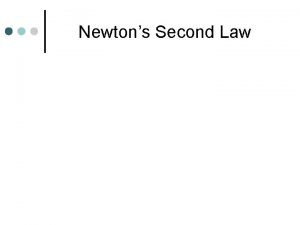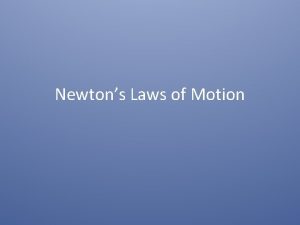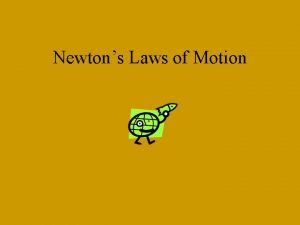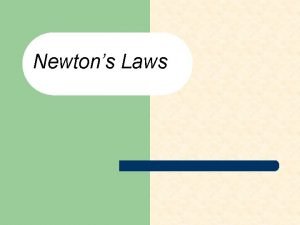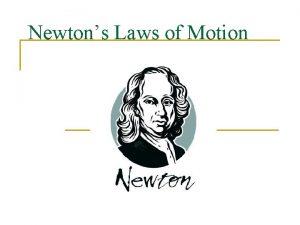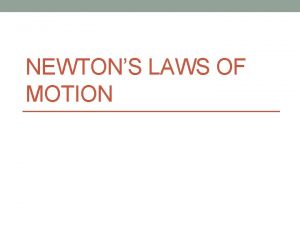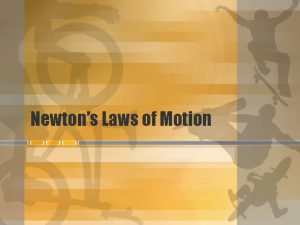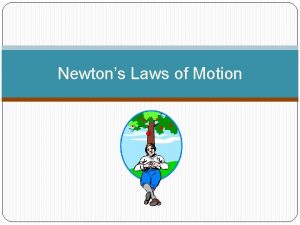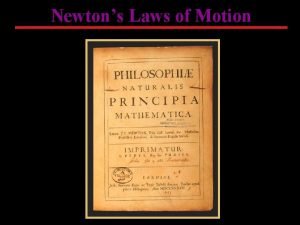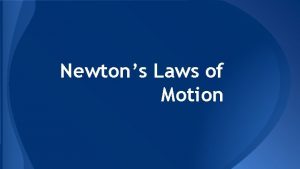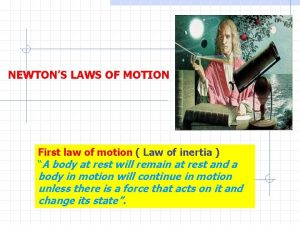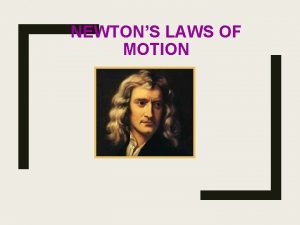Newtons Laws of Motion 1 Newtons First Law




















- Slides: 20

Newton’s Laws of Motion 1

Newtons First Law of Motion or “the law of inertia” “An object continues in its state of rest or uniform motion in a straight line unless acted upon by a net external force” OR (in easier language: ) 2

Newtons First Law of Motion “If forces acting on an object are balanced then: • if it is still then it will stay still. • if it is moving it keeps moving at a constant speed and in a straight line. ” 3

Newtons First Law of Motion This law is also known as the Law of Inertia means not wanting to change what you are doing. Watch Eureka number 1 Watch Eureka 2 4

Friction is a common force. It is experienced whenever 2 things try to slide over each other. In each of the following pictures decide where the friction is and if it is useful or a nuisance or both! 1. 2. 5

3. 4. 6

A recap of last lesson: What is a force? It is a push, pull or twist. What does this mean? A force can • make an object accelerate or decelerate. • make an object change direction. • change the shape of something. • BUT… the force must be unbalanced for these things to happen… 7

Wait! What does UNBALANCED mean? ? ? Lets look at an example: The forces acting on the boy include gravity causing him to push down on the chair and the chair pushing up on him. If his weight was larger than the force the chair legs could exert back on him then he would fall! 8

Wait! What does UNBALANCED mean? ? ? Lets look at an example: The forces acting on the boy include gravity causing him to push down on the chair and the chair pushing up on him. If his weight was larger than the force the chair legs could exert back on him then he would fall! (Look at the relative sizes of the force arrows to see which way he will move. ) 9

What are the units of force? Newtons (N) (after Isaac Newton) What do we measure forces with? A spring balance (Newton Meter). What is a Newton? ? ? One Newton (1 N) is the force required to give a mass of 1 kg an acceleration of 1 m/s 2. Watch Eureka 6 10

Unbalanced Forces Lets look at combining the forces acting on an object to see what the resultant force would be. 12 N Resultant = 0 N 11

Unbalanced Forces 15 N 12 N Resultant = 15 – 12 = 3 N (to the right) 3 N 12

Newtons Second Law of Motion When a net (or unbalanced) force acts on a body, the body is accelerated in the direction of the force. The acceleration is directly proportional to the force and inversely proportional to the mass. Or… F = ma Force = mass x acceleration Watch Eureka 3 13

Lets look at an example: Kay is pushing a box along the floor at a constant velocity with a force of 20 N. The mass of the box is 5 kg. 1. What must the frictional force be? 5 kg 20 N Friction Constant velocity means forces must be balanced so friction will be 20 N too but in the opposite direction! 14

2. When the force is increased to 30 N, what acceleration will Kay be giving the box? ? 5 kg 30 N Friction = 20 N Resultant or Net force = 10 N forward. 15

2. When the force is increased to 30 N, what acceleration will Kay be giving the box? ? 5 kg Resultant 10 N Resultant or Net force = 10 N forward. F = m x a or a = F/m a = 10/5 = 2 m/s 2. 16

We exert a force on the ground due to our mass – what is it? If your mass is 50 kg, the force you exert F=mxa = 50 x acceleration due to gravity (10 m/s 2) = 50 x 10 = 500 N (your weight!) Mass (kg) is just the amount of “stuff” in an object and does not change with gravity!! Watch Eureka 7 17

Newtons Third law For every action there is an equal and opposite reaction. If the wall did not push back on Humpty Dumpty , what would happen to him? 18

Newtons Third law For every action there is an equal and opposite reaction. If the wall did not push back on Humpty Dumpty , what would happen to him? Oooooooops… 19

Summary Newton’s 1 st Law: An object continues in its state of rest or uniform motion in a straight line unless acted upon by a net external force. Newton’s 2 nd Law: When a net (or unbalanced) force acts on a body, the body is accelerated in the direction of the force. The acceleration is directly proportional to the force and inversely proportional to the mass. Terminal Velocity: The highest velocity an object can reach when falling through the air. This occurs when the of from air resistance equal the force due to gravity. Resultant Force: The overall force acting on an object. Unbalanced Force: A force which is not cancelled out by another force. Newton’s 3 rd Law: For every action there is an equal and opposite reaction. The Newton: One Newton (1 N) is the force required to give a mass of 1 kg an acceleration of 1 m/s 2. F = ma Mathematical representation of Newton’s 2 nd Law. Shows the relationship between force, mass and acceleration.
 Newton's first law of motion meme
Newton's first law of motion meme Newtons 1st law.
Newtons 1st law. Newtons laws od motion
Newtons laws od motion What are newtons 3 laws
What are newtons 3 laws The three laws of motion
The three laws of motion 3 newton's law
3 newton's law Newtons 3 rd law of motion
Newtons 3 rd law of motion Newtons 3 rd law of motion
Newtons 3 rd law of motion Chapter 8 ask newton
Chapter 8 ask newton Rd law
Rd law Newtons third law
Newtons third law Newton's third law
Newton's third law Newtons 3 rd law of motion
Newtons 3 rd law of motion Newtons 3 rd law
Newtons 3 rd law Newtons 3 rd law of motion
Newtons 3 rd law of motion Newton's second law
Newton's second law Law of motion examples
Law of motion examples Brainpop newton's laws of motion worksheet answer key
Brainpop newton's laws of motion worksheet answer key Newton's first law and second law and third law
Newton's first law and second law and third law Newton's first law
Newton's first law More inertia
More inertia
